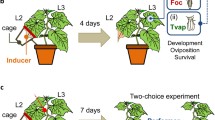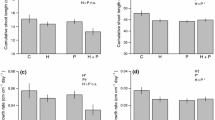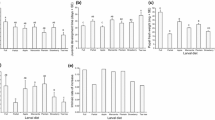Abstract
The frequency of coevolution as a process of strong mutual interaction between a single plant and herbivore species has been questioned in light of more commonly observed, complex relationships between a plant and a suite of herbivore species. Despite recognition of the possibility of diffuse coevolution, relatively few studies have examined ecological responses of plants to herbivores in complex associations. We studied the impact of two specialist herbivores, the horse nettle beetle, Leptinotarsa juncta, and the eggplant flea beetle, Epitrix fuscula, on reproduction of their host, Solanum carolinense. Our study involved field and controlled-environment experimental tests of the impact on sexual and potential asexual reproduction of attack by individuals of the two herbivore species, individually and in combination. Field tests demonstrated that under normal levels of phytophagous insect attack, horse nettle plants experienced a reduction in fruit production of more than 75% compared with plants from which insects were excluded. In controlled-environment experiments using enclosure-exclosure cages, the horse nettle's two principal herbivores, the flea beetle and the horse nettle beetle, caused decreases in sexual reproduction similar to those observed in the field, and a reduction in potential asexual reproduction, represented by root biomass. Attack by each herbivore reduced the numbers of fruits produced, and root growth, when feeding in isolation. When both species were feeding together, fruit production, but not root growth, was lower than when either beetle species fed alone. Ecological interactions between horse nettle and its two primary herbivores necessary for diffuse coevolution to occur were evident from an overall analysis of the statistical interactions between the two herbivores for combined assessment of fruit and vegetative traits. For either of these traits alone, the interactions necessary to promote diffuse coevolution apparently were lacking.
Similar content being viewed by others
References
Abrahamson WG, McCrea KD (1986) Nutrient and biomass allocation in Solidago altissima: effects of two stem gallmakers, fertilization, and ramet isolation. Oecologia 68:174–180
Baldwin IT (1990) Herbivory simulations in ecological research. Trends Ecol Evol 5:91–93
Belsky AJ (1986) Does herbivory benefit plants? A review of the evidence. Am Nat 127:870–892
Berenbaum M (1988) Flea beetles. Horticulture 66:62–63
Berenbaum MR, Zangerl AR (1988). Stalemates in the coevolutionary arms race: synthesis, synergisms, and sundry other sins. In: Spencer KC (ed) Chemical mediation of coevolution. Academic Press, San Diego, pp 113–132
Borror DJ, Triplehorn CA, Johnson NF (1989) An introduction to the study of insects, 6th edn. Saunders College, Philadelphia
Bowers MD (1988) Chemistry and coevolution: iridoid glycosides, plants, and herbivorous insects. In: Spencer KC (ed) Chemical mediation of coevolution. Academic Press, San Diego, pp 133–165
Cain ML, Carson WL, Root RB (1991) Long-term suppression of insect herbivores increases the production and growth of Solidago altissima clones. Oecologia 88:251–257
Campbell JM, Sarasin MJ, Lyons DB (1989) Canadian beetles (Coleoptera) injurious to crops, ornaments, stored products, and buildings (publication 1826). Agriculture Canada, Ottawa
Craig TP, Price PW, Clancy KM, Waring GL, Sacchi CF (1988) Forces preventing coevolution in the three-trophic-level system: willow, a gall-forming herbivore, and parasitoid. In: Spencer KC (ed) Chemical mediation of coevolution. Academic Press, San Diego, pp 57–80
Crawley MJ (1983) Herbivory, the dynamics of animal-plant interactions. University of California Press, Berkeley
Crawley MJ (1987) Benevolent herbivores? Trends Ecol Evol 2:167–168
Crawley MJ (1989) Insect herbivores and plant population dynamics. Annu Rev Entomol 31:531–564
Da Costa CP, Jones CM (1971) Cucumber beetle resistance and mite susceptibility controlled by the bitter gene in Cucumis sativus L. Science 172:1145–1146
Dirzo R (1984) Herbivory: a phytocentric overview. In: Dirzo R, Sarukhan J (eds) Perspectives on plant population ecology. Sinauer, Sunderland, pp 141–165
Doak DF (1992) Lifetime impacts of herbivory for a perennial plant. Ecology 73:2086–2099
Duncan WH, Foote LE (1975) Wildflowers of the Southeastern United States. University of Georgia Press, Athens
Fay PA, Hartnett DC (1991) Constraints on growth and allocation of Silphium integrifolium (Asteraceae) caused by a cynipid gall wasp. Oecologia 88:243–250
Fox LR (1981) Defense and dynamics in plant-herbivore systems. Am Zool 21:853–864
Futuyma DJ (1983) Evolutionary interactions among herbivorous insects and plants. In: Futuyma DJ, Slatkin M (eds) Coevolution. Sinauer, Sunderland, pp 207–231
Futuyma DJ, Slatkin M (1983) Introduction. In: Futuyma DJ, Slatkin M (eds) Coevolution. Sinauer, Sunderland, pp 1–13
Gould F (1988) Genetics of pairwise and multispecies plant-herbivore coevolution. In: Spencer KC (ed) Chemical mediation of coevolution. Academic Press, San Diego, pp 13–55
Hardin JW, Doerksen G, Herndon H, Hobson M, Thomas F (1972) Pollination ecology and floral biology of four weedy genera in southern Oklahoma. Southwest Nat 16:403–412
Hare JD (1990) Ecology and management of the Colorado potato beetle. Annu Rev Entomol 35:81–100
Hare JD, Futuyma DJ (1978) Different effects of variation in Xanthium strumarium L. (Compositae) on two insect seed predators. Oecologia 37:109–120
Hare JD, Kennedy GG (1986) Genetic variation in plant-insect associations: survival of Leptinotarsa decemlineata populations on Solanum carolinense. Evolution 40:1031–1043
Hartnett DC, Abrahamson WG (1986) The effects of stem gall insects on life history patterns in Solidago canadensis. Ecology 60:910–917
Heithaus ER, Stashko E, Anderson PK (1982) Cumulative effects of plant-animal interactions on seed production by Bauhinia ungulata, a neotropical legume. Ecology 63:1294–1302
Hendrix SD (1988) Herbivory and its impact on plant reproduction. In: Lovett Doust J, Lovett Doust L (eds) Plant reproductive ecology. Oxford University Press, New York, pp 246–263
Hougen-Eitzman D, Rausher MD (1994) Interactions between herbivorous insects and plant-insect coevolution. Am Nat 143: 677–697
Hsiao TH (1986) Specificity of certain chrysomelids for Solanaceae. In: D'Arcy WG (ed) Solanaceae: biology and systematics. Columbia University Press, New York, pp 345–377
Huitema BE (1980) The analysis of covariance and alternatives. Wiley, New York
Inouye DW (1982) The consequences of herbivory: a mixed blessing for Jurinea mollis (Asteraceae). Oikos 39:269–272
Jacques RL (1988) The potato beetles: the genus Leptinotarsa in North America (Coleoptera: Chrysomelidae) (Flora and Fauna Handbook No. 3. E.J. Brill, New York
Janzen DH (1979) New horizons in the biology of plant defenses. In: Rosenthal GA, Janzen DH (eds) Herbivores: their interaction with secondary plant metabolites. Academic Press, New York, pp 331–350
Janzen DH (1980) When is it coevolution? Evolution 34:611–612
Jermy T (1976) Insect-host-plant relationship-coevolution or sequential evolution? In: Jermy T (ed) The host-plant in relation to insect behavior and reproduction. Plenum, New York, pp 109–113
Jermy T (1984) Evolution of insect/host plant relationships. Am Nat 124:609–630
Jones VP, Toscano NC, Jonson MW, Welter SC, Youngman RR (1986) Pesticide effects on plant physiology: integration into a pest management program. Bull Entomol Soc Am 32:103–109
Kiltz BF (1930) Perennial weeds which spread vegetatively. J Am Soc Agron 22:216–234
Kleinbaum DG, LL Kupper (1978) Applied regression analysis and other multivariable methods. Duxbury Press, North Scituate
Louda SM (1984) Herbivore effect on stature, fruiting, and leaf dynamics of a native crucifer. Ecology 65:1379–1386
Maddox GD, Root RB (1990) Structure of the encounter between goldenrod (Solidago altissima) and its diverse insect fauna. Ecology 71:2115–2124
Marquis RJ (1992) The selective impact of herbivores. In: Fritz RS, Simms EL (eds) Plant resistance to herbivores and pathogens. University of Chicago Press, Chicago, pp 301–325
Maschinski J, Whitham TG (1989) The continuum of plant responses to herbivory: the influence of plant association, nutrient availability, and timing. Am Nat 134:1–19
McNaughton SJ (1983) Compensatory plant growth as a response to herbivory. Oikos 40:329–336
McNaughton SJ (1986) On plants and herbivores. Am Nat 128:765–770
Meyer GA (1993) A comparison of the impacts of leaf-and sap-feeding insects on growth and allocation of goldenrod. Ecology 74:1101–1116
Meyer GA, Root RB (1993) Effects of herbivorous insects and soil fertility on goldenrod reproduction. Ecology 74:1117–1128
Norusis MJ (1990) SPSS/PC+ advanced statistics 4.0. SPSS, Chicago
Owen DF, Wiegert RG (1976) Do consumers maximize plant fitness? Oikos 27:488–492
Paige KN, Whitham TG (1987) Overcompensation in response to mammalian herbivory: the advantage of being eaten. Am Nat 129:407–416
Radford AE, Ahles HE, Bell CR (1968) Manual of the vascular flora of the Carolinas. University of North Carolina Press, Chapel Hill
Sacchi CF, Price PW, Craig TP, Itami JK (1988) Impact of shoot galler attack on sexual reproduction in the arroyo willow. Ecology 69:2021–2030
Simberloff D, Brown BJ, Lowrie S (1978) Isopod and insect root borers may benefit Florida mangroves. Science 201:630–632
Simms EL, Fritz RS (1990) The ecology and evolution of hostplant resistance to insects. Trends Ecol Evol 5:356–360
Simms EL, Rausher MD (1987) Costs and benefits of plant resistance to herbivory. Am Nat 130:570–581
Simms EL, Rausher MD (1989) The evolution of resistance to herbivory in Ipomoea purpurea. II. Natural selection by insects and costs of resistance. Evolution 43:573–585
Sokal RR, Rohlf FJ (1981) Biometry, 2nd edition. Freeman, New York
Solomon BP (1981) Response of a host-specific herbivore to resource density, relative abundance, and phenology. Ecology 62:1205–1214
Solomon BP (1983) Compensatory production in Solanum carolinense following attack by a host-specific herbivore. J Ecol 71:681–690
Stamp NE (1984) Effects of defoliation by checkerspot caterpillars (Euphydryas phaeton) and sawfly larvae (Macrophya nigra and Tenthredo grandis) on their host plants (Chelone spp.). Oecologia 63:275–280
Stenseth NC (1978) Do grazers maximize individual plant fitness? Oikos 31:299–306
Strausbaugh PD, Core EL (1978) Flora of West Virginia. Seneca, Grantsville
Strauss SY (1991) Direct, indirect, and cumulative effects of three native herbivores on a shared host plant. Ecology 72:543–558
Strong DR, Lawton JH, Southwood R (1984) Insects on plants. Harvard University Press, Cambridge
Thompson JN (1986) Patterns in coevolution. In: Stone AR, Hawksworth DI (eds) Coevolution and systematics. Clarendon, Oxford, pp 119–143
Tisdell TF (1961) A life cycle study of horse nettle (Solanum carolinense). Ph. D. Dissertation, Rutgers University, New Brunswick, New Jersey, USA
Tower WL (1906) An investigation of evolution in chrysomelid beetles of the genus Leptinotarsa (publication 48). Carnegie Institute, Washington
Waloff N, Richards OW (1977) The effect of insect fauna on growth mortality and natality of broom, Sarothamnus scoparius. J Appl Ecol 14:787–798
Winder JA, Emden HF van (1980) Selection of effective biological control agents from artificial defoliation/insect cage experiments. In: Delfosse ES (ed) Proceedings of the Vth international symposium on the biological control of weeds. Commonwealth Scientific and Industrial Research Organization, Australia. pp 415–439
Winder JA, Harley KLS (1982) The effects of natural enemies on the growth of Lantana in Brazil. Bull Entomol Res 27:599–616
Author information
Authors and Affiliations
Rights and permissions
About this article
Cite this article
Wise, M.J., Sacchi, C.F. Impact of two specialist insect herbivores on reproduction of horse nettle, Solanum carolinense . Oecologia 108, 328–337 (1996). https://doi.org/10.1007/BF00334658
Received:
Accepted:
Issue Date:
DOI: https://doi.org/10.1007/BF00334658




